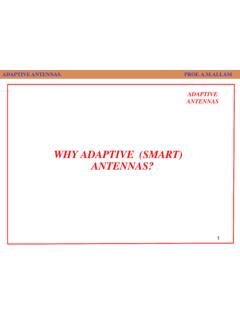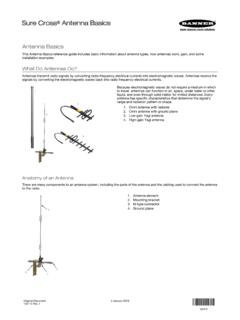Transcription of The Antenna Balun - laarrl.org
1 The Antenna BalunWhat is this thing and why do I need it?In this chapter we will look at a common component in some transmission systems the Balun . It is quite common to see a Balun in wire antennas of all sizes, production quality, and brand name. Well what is this thing and why do we need it? Is it good for anything else or is it just for wire antennas?The term Balun is formed from two words: balanced and unbalanced. It can be correctly inferred that this device services both balanced and unbalanced components. They are generally divided into two classes: Current Baluns and Voltage BalunsCurrent baluns allow each output terminal's voltage, with respect to "ground" or chassis, to float to any value required to provide equal currents to each feedline conductor. Current baluns are universal devices that work with balanced or unbalanced loads equally well. Current baluns add common-mode isolation between systems connected at each end.
2 While traditionally used as baluns, they work well as broadband phase-invertors or as an baluns isolate or add impedance to unwanted common-mode current paths, reducing or controlling common-mode current. Current baluns are the Balun of choice in all but veryspecialized situations, because they work better than voltage baluns in most real-world the case of a 1:1 ratio current Balun , core flux density or "magnetizing stress" on the Balun core isindependent of load impedance or load mismatch. Only common-mode current affects the does not mean current baluns can handle infinite power or mismatch, but it does mean for equal materials and cost they handle extremes in impedance much better than baluns that operate at higher BalunsVoltage baluns always try to force the output terminals to equal voltages. They sometimes introduce phase shift between each output terminal and "ground". If the impedance presented at each terminal is not exactly equal, feedline or load currents will not be equal and opposite.
3 This means the feedline will Choke Balun Courtesy G4 APLH omebrew Toroid BalunThey also do not provide common-mode isolation. A voltage Balun almost certainly guaranteessome feedline radiation (or reception), because there are very few "perfectly balanced" loads orperfect voltage a 1:1 ratio current Balun , a voltage Balun will always magnetize its core in direct proportionto load voltages. In a voltage Balun , load impedance directly affects core heating and flux density. It might seem intuitive to think that VSWR solutions might involve a voltage type Balun . Current baluns, rather than voltage baluns, should be used whenever possible. Current baluns provide better balance and often have lower loss. Current baluns, especially 1:1 ratio baluns, tolerate load impedance and balance variations much better than voltage baluns. Current baluns can also be used as isolators or unun' typeIn an autotransformer, two coils on a ferrite rod can be used as a Balun by winding the individual strands of insulated (usually enameled) wire comprising the coil very tightly wound together.
4 This winding can take one of two forms: either the two windings must be wound such that the two form a single layer where each turn is touching each of the adjacent turns of the other winding; or the two wires are twisted together before being wound into the two windings are joined to become a single coil. The end of one of the windings on one side of the coil is connected to the end of the other winding on the other side of the coil. This point then becomes the ground for the unbalanced circuit. One of the remaining ends is connected to the ungrounded side of the unbalanced circuit, and one side of the balanced circuit. Finally, the other side of the balanced circuit is connected to the remaining transformer typeIsolated transformers have a real impedance at a resonance frequency where self-inductance and self- capacitance for each individual winding cancel themselves transformer typeBaluns can be considered to be simple forms of transmission line more complex (and subtle) type results when the transformer type (magnetic coupling) is combined with the transmission line type (electro-magnetic coupling).
5 This is where whole transmission lines are used as windings, resulting in devices capable of very wideband operation. This whole class known generally as "Transmission Line Transformers" spawn their own huge variety. Very commonly, they use small ferrite cores in toroidal or "binocular" shapes. Something as simple as 10 turns of coaxial cable coiled up on a diameter about the size of a dinner plate makes an extremely effective choke Balun for frequencies from about 10 MHz to beyond 30 MHz. The magnetic material may be "air", but it is a transmission line 1:1 Balun using a toroidal core and coaxial cable. This simple RF choke works as a Balun by preventing signals passing along the outside of the braid. Such a device can be used to cure television interference by acting as a so-called braid-breaker .The Guanella transmission line transformer is often combined with a Balun to act as an impedance matching transformer. Putting balancing aside a 1:4 transformer of this type consists of a 75 Ohm transmission line divided in parallel into two 150 Ohm cables, which are then combined in series for 300 Ohm.
6 It is implemented as a specific wiring around the ferrite core of the line typeA large class of baluns uses connected transmission lines of specific lengths, with no obvious "transformer" part. These are usually built for (narrow) frequency ranges where the lengths involved are some multiple of a quarter wavelength of the intended frequency in the transmission line medium. A common application is in making a coaxial connection to a balanced Antenna , and designs include many types involving coaxial loops and variously connected "stubs".One easy way to make a Balun is a one-half wavelength ( /2) length of coaxial cable. The inner core of the cable is linked at each end to one of the balanced connections for a feeder or dipole. One of these terminals should be connected to the inner core of the coaxial feeder. All three braids should be connected together. This then forms a 4:1 Balun which works at only one narrow band design is to use a /4 length of metal pipe.
7 The coaxial cable is placed inside the pipe; at one end the braid is wired to the pipe while at the other end no connection is made to the pipe. The balanced end of this Balun is at the end where the pipe is wired to the braid. The /4 conductor acts as a transformer converting the infinite impedance at the unconnected end into a zero impedance at the end connected to the braid. Hence any current entering the Balun through the connection, which goes to the braid at the end with the connection to the pipe, will flow into the pipe. This Balun design is not good for low frequencies because of the long length of pipe that will be needed. An easy way to make such a Balun is to paint the outside of the coax with conductive paint, then to connect this paint to the AntennasMost hams think of a balanced Antenna component as something like a loop wire Antenna . The truth is that any dipole Antenna ( Antenna with two connections not connected to ground) is a balanced component.
8 Balanced referring to a device that demands relatively equal currents from both feedpoint terminals. Examples of balanced feedpoint antennas are; Beams, Yagi s, dipoles, wire loops and quagi AntennasWhen one Antenna feedpoint connection is to ground, the Antenna is generally considered to be unbalanced . That is to say RF tends to flow on the radiating element and the current for the other connection is in, or along the surface of the ground. Examples of this type Antenna are: Vertical monopole and trapped vertical antennas or single wire vertically erected antennas such as the inverted L and types of antennaeThere are some types of antennas that seem to defy simple definitions. Take for example the so-called Carolina Windom. The Windom dipole is an off-center fed dipole. That is, one side is generally longer than the other measured from the feedpoint connections. This particular Antenna takes advantage of a phenomenon whereby feedpoint impedance increases as you move away from the center of a dipole.
9 This off-center placement allows a Balun to have a higher matching ratio than the normal :1 used on most dipoles. Currents do not flow equally in both feedline connections, necessitating the use of the Balun to connect to the unbalanced coaxial feedline and to prevent common mode radiation. The Balun , Antenna wire connections, and coax connection, is normally built into the center mounting hardware. A certain length of impedance matching coax of higher impedance is also used to bring the resulting impedance to more closely match 50 ohms. In some versions, this coax acts as a broadband feedline Balun instead of the usual transformer G5RV Antenna is similar with the exception that a length of open twin wire feed line or ladder line is used to create a broadband feedline Balun before connecting to the coax. Both types of antennas are world renown for their unique characteristics in the 40 meter and 20 meter bands. There is even a 17 meter DX version available from some suppliers and homebrew designs are antennas and the BalunSo what about the vertical Antenna ?
10 Does it need a Balun ? The short answer is no. But it is more involved than that. Vertical antennas carry RF currents just as beams and dipoles. The major difference is that one of the feedpoints is ground. Quite often, vertical antennae are directly connected to the coaxial feedline. However, it is possible to isolate the Antenna from earth ground and the transmitting system by use of an unbalanced to unbalanced device known as a unun. Just as the Balun provides its effect by isolation, the unun separates the unbalanced Antenna from the unbalanced coax cable through the same transformer action. In situations where isolation is necessary to combat common mode currents from ground, the unun is more than appropriate. Common mode currents from ground usually occur where the resistance of the ground system of the Antenna is different than the ground resistance of the rig. This resistive difference is manifested by a larger potential difference from one end to the other of the coax.









